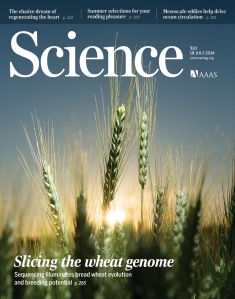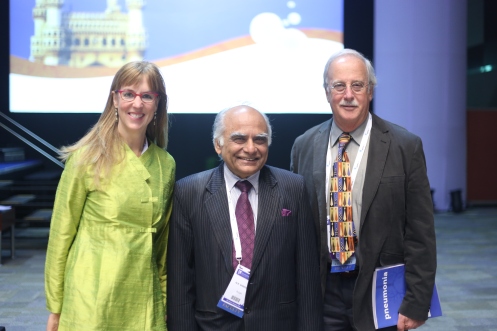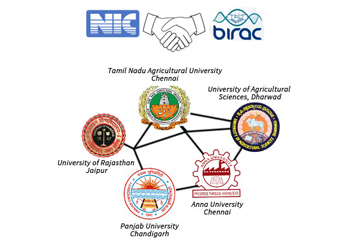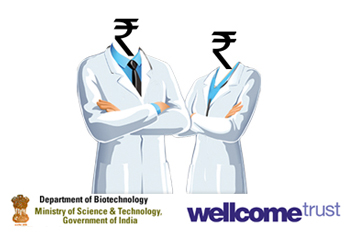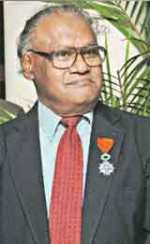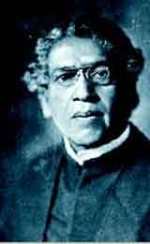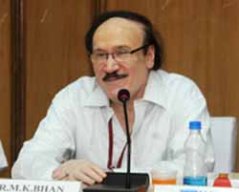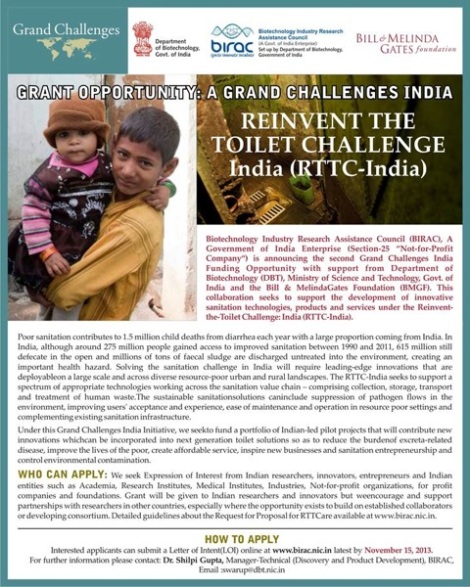Dr Partha Majumder, the founder director of the National Institute of Biomedical Genomics has recently been elected to the Membership of the International Statistical Institute, The Hague, in recognition for his contributions to statistics. He spoke to Chief Editor of DBT Communication cell on his plans to accelerate interaction between various disciplines of science for better understanding of human health and disease.

You have been the Director of NIBMG since its inception. Now you have become an elected member of International Statistical Institute. Can this lead to collaborative research between these two institutes.
The International Statistical Institute (ISI; not to be confused with the Indian Statistical Institute, Kolkata), The Hague, is essentially an umbrella organization. The Institute promotes statistical science, formulates statistical policies and facilitates networking among statisticians and statistical organizations. The one plan that I have is to get into a long-term understanding with the ISI for organizing training programs in statistical genetics at the NIBMG. Initiation of joint training activities will also place members of NIBMG’s faculty in touch with statisticians working in human genetics in other global institutions, which will surely serve as a catalyst for collaborative research engagement.
What are the areas in which the two institutes can gain or learn from each other?
NIBMG is engaged in generation and statistical analysis of massively parallel DNA and RNA sequence data. These activities are throwing up massive data sets and complex statistical problems. Development and fostering of relationships between ISI and NIBMG will help find solutions to the statistical challenges of analysing and drawing inferences from massive inter-related genomic and proteomic data sets relevant to human health and disease.
Boundaries of disciplines are merging with interdisciplinary research becoming the way forward. What does our country need to do to integrate this spirit of interdisciplinary research into our system?
Like “doctors without borders,” NIBMG is an institution without Units or Departments. We have done so deliberately, in recognition of interdependence of various disciplines of science in our quest for understanding human health and disease. What does our country need to do? Here is a brief recipe:
(a) Encourage collaborations among scientists of institutions with disparate scientific foci by providing institutional support, such as adjunct professorships, fellowships to work across institutions, formal access to technology platforms across institutions, etc.;
(b) Organize inter-disciplinary training programs for graduate students even if short-term, such as summer or winter schools; and
(c) Provide larger grants for inter-disciplinary research.
Having said this, it is my belief that formation of interdisciplinary teams of scientists will be accelerated by the increased understanding that the complexity of biological problems requires multiple types of arsenal for gaining insights.
Are there robust examples of interdisciplinary research that the country could learn from? How would you set examples that can be emulated later?
Statisticians and biologists have always collaborated to solve problems in human genetics. This example is very robust and long-standing. Long-standing, because it is a natural coalition. Because of ethical and other issues, you cannot design experiments with humans. Necessarily, therefore, inferences have to be made from observational studies. Inferences from such data cannot be drawn without using statistical methods. I really don’t think that any examples of interdisciplinary research need to be set for later emulation. What is most important is to encourage deeper biological investigations, which necessarily will have to use concepts and methods from multiple disciplines of science. “Go deep and fund well.”
What are the still unaddressed research challenges in your area—population genetics in general and genetics of cancer in particular in the Indian context. Suggest a few steps that you will take to address them and how will your new position help that.
The greatest research challenge in biomedical genomics is to find methods for extracting high-quality and robust information from massive data sets. I don’t have a roadmap to do this! Concerted efforts by statisticians, biologists, bio-informaticians, computer scientists, etc. will be required. I am hoping that I will be able to negotiate with the governors of ISI to invite eminent statisticians and statistical geneticists to NIBMG and have them engage with our scientists. I also plan to facilitate eminent statisticians visit other biology institutions in India and engage with their scientists. Through engagement, there will be scientific benefit.
What are the human capacity challenges and the technological challenges and how would you like to address them. Will the new membership help?
Quantitative thinking, statistical science and computation have become integral to biomedical genomics, even of biology in general. Students in India pursue higher education in biology if they are not comfortable with mathematics. Unfortunately, when they get into biological research, they find themselves back into numbers, formulas and equations that they had dreaded in high school! Thus, there is a human capacity challenge. Again, I do not have a roadmap, but hopefully through coursework and short-term training during their biological research pursuits, they can be made to learn and improve their quantitative skills. Interestingly, increasing numbers of mathematicians and statisticians are taking interest in biological research, which is great. Technology manufacturing is in the hands of a small number of companies, whether we like it or not. All institutions in the world purchase their technology platforms from these companies. The challenge for us is to have enough money to purchase these platforms and reagents! Timely access for acquisition of these platforms is no longer a problem.
With your new esteemed membership how will you bring about an improvement in funding to make your research and institutional dreams come true
No ideas here!
What is your promise and hope for young statisticians to encourage them take up new fields of application and researchers from other disciplines to encourage them to develop statistical capabilities that can help them in their research? Can ISI play a constructive role in supporting both these groups?
It is really heartening that young statisticians are increasingly getting into applied research in biomedical sciences. They are seeing opportunities in massive data sets that require innovation in analysis and integration. ISI has been playing a major role in setting directions about the roles of statisticians in “big data science.” ISI and the Royal Statistical Society had organized a discussion meeting in London last year on “big data” (I was privileged to be invited to the meeting and to share my experience in “big data” analysis), which has resulted in a white paper charting the future course of statistical science. Hopefully, NIBMG will engage with ISI more thickly to accelerate interaction of biomedical genomics and statistical science.
Rapid fire
Draft sequence of wheat bread genome ready
DNA markers generated can help produce wheat variety of better quality
First time that draft sequence results are made available to the research community
India played a major role through research work of three institutions supported by DBT
Scientists have successfully brought out the draft sequence of the wheat bread genome. The work which was carried out by a consortium of scientists from 14 countries who sequenced isolated chromosome arms has been published in a paper in the journal Science (July 18, 2014 issue).
India has played a major role as three Indian institutionsPunjab Agricultural University, Ludhiana, National Research Centre on Plant Biotechnology (NRCPB) and University of Delhi, South Campus, New Delhi sequenced the 2A genome with the support of the Department of Biotechnology.
The decoding of wheat genome may help in identifying more than 125,000 genes of which about 50 percent have been assigned to individual wheat chromosomes. This four years effort by the International Wheat Genome Sequencing Consortium (IWGSC) has opened gates for understanding the biological function of each of these genes.The current draft sequence would generate thousands of DNA markers which could be used as ‘tag’and eventually help track particular genes responsible for certain traits of interest. It will help plant breeders to produce new high quality cultivars, with better yield, disease and pest resistance, abiotic stress tolerance and richer in essential micronutrients.
For each gene in wheat there are three copies, one from each of the three genomes, and in most cases only one copy expresses. How the plant decides which copy of the gene to express is most intriguing question in wheat biology. Availability of chromosome based sequence has opened new horizons for researching this issue.
While earlier private companies have claimed to have decoded the raw wheat genome sequence data, this is the first time that the sequence results are available to the public through IWGSC. It has been called a draft sequence because the blue print at present assembles only about 60 per cent of the genome and the team expects to assemble the complete genome in next 3-4 years.
Completion of the wheat genome reference sequence is essential to accelerate breeding and the rapid identification of genes underlying complex traits such as yield, disease and pest resistance, or a-biotic stress tolerance. The genome sequence will aid breeders by enabling new strains to be developed, including new “stacked” trait combinations, and by allowing the development of accelerated and smarter breeding schemes. This in turn will decrease the time from discovery to commercialisation of new varieties for farmers.
In nature, bread wheat evolved after cross hybridization of three different but closely related species. This evolutionary feature made it to accumulate largest content of DNA among all the food crops, making wheat genetics more complex in comparison. Ten years ago, wheat was considered one of the toughest crops to decode due to its huge genome size of 17000 million base pairs, and presence of three sets of highly similar chromosomes in the genome and a very large proportion of repetitive DNA (ranging from 80-90%).
Technological advances in DNA sequencing made in recent years and availability of specialized wheat lines, each having one chromosome arm added in duplicate to the normal chromosomes complement, developed during 1950s in wheat variety ‘Chinese Spring’ made it possible to isolate individual chromosomes for sequencing. The chromosome-based draft sequence provides new insight into the structure, organization, and evolution of the large, complex genome of the world’s most widely grown cereal crop.
The genome reference sequence will act as a benchmark point for understanding the differences between varieties that are associated with different traits, and provide breeders and plant scientists with a molecular toolkit for marker-based selection, high throughput screening, and the association of traits with specific genes and proteins. It holds the key to the production of a new generation of wheat varieties that will enable higher yields and improved sustainability of wheat production systems.
Chief Editor
DBT Communications cell
Scientists and public health experts from around the world who met at Hyderabad agreed there were sufficient data to mull over introducing PCV, a vaccine for pneumonia and meningitis in India.
The vaccine, scientifically called pneumococcal conjugate vaccine was a crucial topic of discussion at the 9th International Symposium on Pneumococci and Pneumococcal Diseases, ISPPD from March 9th to 13th.
It can prevent infection by the bacterium Streptococcus pneumoniae (which also goes by pneumococcus). The bacterium is one of the leading causes of pneumonia and meningitis, a severe infection of the protective covering of the brain and spinal cord.
It is one of the leading causes of death globally, taking the lives of more than 1 million children less than five years of age annually. More than 20% of the deaths take place here in India. The number of cases of pneumonia that do not result in death, referred to as morbidity, is also cause for great concern.
In India and around the world 1 in 5 children who develop meningitis die and among those who survive, over 30% suffer permanent disabilities such as deafness, seizures, mental and developmental delays.
Based on recent estimates, more 65,000 Indian children died from pneumococcal disease in 2012. Many more were hospitalized. Additionally, the burden to families of children with pneumococcal disease is enormous. Hospitalisations alone have been estimated to cost Rs2000-14000 for pneumonia and more than Rs 50,000 for meningitis. In addition, such illnesses cause an enormous economic burden to the families since they often have to miss work in order to provide care for these children.
In order to discuss the increasing disease burden caused by the bacterium specially in this part of the world and find solutions to the problem, the ISPPD was held in India. This was the first time that this global meeting focused on understanding pneumococcus and addressing pneumococcal disease was held in Asia.
It brought together around 1,000 experts from more than 70 countries. The meeting was unique in its focus on scientific research and emphasis on research collaborations.
The important genomic and epidemiologic findings that were discussed at the meeting could lead to improved pneumococcal disease interventions which could benefit not only India, but all countries in this region.
Some of the interesting topics that were discussed included host and environmental factors associated with pneumococcal disease susceptibility and severity, interactions between pneumococcus and other bacteria that colonise the upper respiratory tract, new microbiological and genetic techniques for determining serotypes of pneumococcus and progress in the development of newer generations of vaccines and the immunologic approaches that researchers are exploring.
For countries planning to introduce pneumococcal conjugate vaccine (PCV), two topics were particularly relevant. They were current data on serotype replacement and vaccine impact studies.
More than 100 countries have already introduced PCV. In South Asia, Pakistan and Afghanistan have introduced PCV into their national programmes. This year, Nepal and Bangladesh will also add PCV to their schedule and a number of other countries will introduce the vaccine by 2016. These experiences of introduction and consideration of evidence for decision-making were shared at the symposium. It was also discussed that vaccine impact studies post-introduction will provide continued evidence for evidence-informed decisions.
The meeting takes place every two years in different countries around the world in collaboration with a local partner organisation. This year, ISPPD was hosted by the INCLEN Trust, a consortium of epidemiologists, social scientists, and health care professionals based in Delhi working on a variety of pressing public health concerns.
It is particularly fitting that this historic and important meeting took place at Hyderabad since over one third of the pneumococcal disease burden comes from India or the neighboring countries.
Currently pneumococcal vaccines seem to be the best answer to the problem and this justifies its inclusion in the National Immunization Programme. However, the current cost of the vaccine is prohibitive, and hence we need to explore partnerships that can offer options for subsidizing it to reach the benefit to the marginalised community which need it the most.
With inputs from Lois Privor-Dumm
A national stock and research centre, a portal for exchange of research information, training of undergraduates and graduates and access to reagents are key requirements suggested at this year’s fly meet
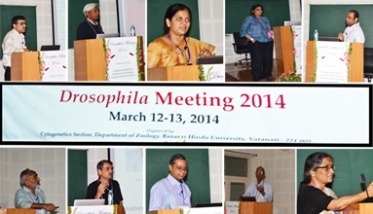
India’s need for a National Drosophila Stock & Research Centre to help researchers to use the economic and efficient fruitfly model for analyses of a diverse range of contemporary basic and applied research issues was highlighted in the Drosophila meeting 2014 at the Banares Hindu University in March.
A ‘Fly Board’ appointed during the meeting would soon submit a proposal to the Department of Biotechnology for establishment of this centre.
The meeting showed a rising trend of the use of the fruitfly model by researchers in the country. However, the limited access to fly stocks and reagents that are otherwise freely available internationally has deterred this growth.
Scientists at the meeting also pointed out that they are severely handicapped due to inadequate student training at the under-/post-graduate levels and due to limited access to the up-to-date knowledge base. The National Stock & Research Centre could fill these gaps.
Yet, there was much reason for optimism. It was evident from the presentations at the meeting that despite the limitations, there are many pockets of excellence. Several laboratories have made significant advances in their research and some are indeed comparable to their colleagues elsewhere in the world.
The need now is to spread such research on a much wider scale in the country so that Indian researchers can actively participate in technology development using Drosophila.
Besides, setting up the national centre, other routes of achieving this were discussed– ways of facilitating the process of procuring Drosophila stocks by individual scientists/ institutions from abroad, ways to spread the use of Drosophila in class-room teaching at under- and post-graduate courses across the country, setting up a system of continuous information exchange about new research findings and new reagents (mutants, clones, transgenic lines etc) generated in different laboratories and organizing future Drosophila meetings on a regular schedule.
The scientists agreed, addressing the issues would help existing fly researchers make better use of their efforts and also aid more groups to come up and develop new questions using ‘simple’ model organisms.
It was decided that an ad hoc Indian Fly Board comprising of Professor S C Lakhotia from BHU, Varanasi, Prof L S Shashidhara from Indian Institute of Science Education and Research (IISER), Pune, Dr Lolitika Mandal from IISER, Mohali, Dr Vijay K. Sharma from Jawaharlal Nehru Centre for Advanced Scientific Research (JNCASR), Bangalore, Dr Mousumi Mutsuddi from BHU, Varanasi and Dr Upendra Nongthomba from IISc, Bangalore would develop directions.
The meeting organized by the Cytogenetics Section, Department of Zoology, Banaras Hindu University brought together more than 90 active research groups in India who are currently utilizing Drosophila as a model organism to pursue their research interests.
They shared information on ongoing research programmes so that better networking and collaborations can be forged between Indian fly researchers. Altogether 44 group leaders from across India participated in this meeting and each presented an overview of their research programmes.
Presentations at the meeting showed that research focus of the Drosophila community in India can be classified into the following broad categories: a) disease models, toxicology and stress biology; b) ecological and evolutionary studies including research on cytogenetics of laboratory scale speciation; c) molecular and cellular analyses of circadian rhythms; d) molecular basis and cell biology of gene expression, regulation and signaling during development; e) developmental cell biology of stem cells, tissue morphogenesis and differentiation.
The well attended lectures generated extensive discussion. It was evident that fly researchers in the country are successfully exploiting the enormous advantage of the exquisite molecular-genetic technology offered by the Drosophila model for analysis of diverse cellular of biology from the molecular to the systems and behavioural levels.
Scientists pointed out that the proposed National Drosophila Stock and Research Centreshould preferably be housed as an autonomous centre within a University campus in partnership with DBT and should have adequate staff, space and infrastructure, which should be fully supported on a long-term basis by DBT.
It should have mandates to function as a national stock centre, undertake research, including development of newer technologies, provide adequate facilities to researchers for undertaking extensive genetic screens, train university/college and school teachers in using fly for classroom learning, and organise fly meetings and training workshops in research methodologies.
The board will also work out strategies to develop a web portal for continuous exchange of information about new research findings and new reagents (mutants, clones, transgenic lines etc) generated in different laboratories in the country.
Researchers agreed that the model was not only useful in research but was also an effective teaching tool to disseminate a variety of biological concepts, at a cost much less than many other alternatives.
In order to nurture this potential, the ad hoc Indian Fly Board will develop a structure to initiate discussions and steer the process of generating curricula and laboratory manuals for teaching Genetics, Cell & Developmental Biology and Systems Biology using Drosophila in class rooms. It will also suggest suitable modules for using Drosophila for teaching ecology, evolutionary and behavioral biology.
Scientists agreed that Drosophila Meetings would be held every year at a suitable location which is accessible to all participants and at affordable costs. Students and faculty members should be encouraged to participate along with other academic members of their labs in them.
Despite the limited resources, the fly community of India has travelled a long road. We will all look forward to escalation of the proposed activities which could help the community not only to become internationally influential in research but would also let it contribute to development of newer reagents for world-wide use.
Contact Professor Subhash Lakhotia for further details
With inputs from Raghu Padinjat, Krishanu Ray and Subhash Lakhotia
India is enthusiastically committed to this multilateral programme of collaboration in the fundamental life sciences, and Indian scientists are applying in large numbers, but success rates are as yet low…
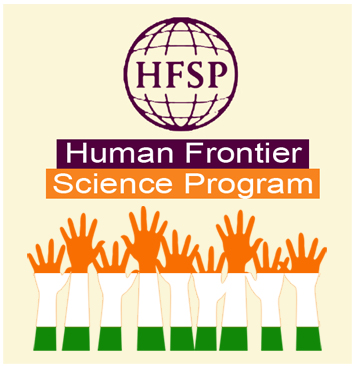
When Roman Stocker at Massachusetts Institute of Technology (MIT)in the USA and Assaf Vardi at the Weizmann Institute of Science in Israel took the surprisingly sophisticated collage of a coral-derived ‘whirlpool’ while showing how coral polyps maintain their micro-environment, they may not have guessed that they could be up for a major international science prize.
To their pleasant surprise they, together with their post-docs Vicente Fernandez, Orr Shapiro and Melissa Garren have won the NSF/AAAS International Science & Engineering Visualization Challenge in the photography category. The winning image has been selected for the cover of Science magazine (7 February 2014, Vol. 343, #6171).
Notably, Stocker and Vardi are grant awardees of the Human Frontier Science Programme (HFSP), in which India is deeply involved as one of the funding nations. This visualisation challenge award is but one example of the many kinds of exciting work that is possible with HFSP grants.
Yet another example is the fact that all the Nobel laureates in physiology and medicine this year, James Rothman, Randy Schekman and Thomas Sudhof, have been HFSP grant awardees; in fact, over its short quarter-century lifespan, HFSP has funded twenty-three Nobel laureates!
But the HFSP programme is yet to see significant successes for Indian scientists in terms of grants received. The long list of 2014 awardees (released on March 20) under Research Grant Awards (thirty four of them), Career Development Awards (twelve of them), Long Term Fellowships (eighty of them) and Cross-Disciplinary Fellowships (ten of them) sees only a scattering of researchers from Indian institutions.
Congratulations go to these rarities: Yamuna Krishnan from National Centre for Biological Sciences, Tata Institute of Fundamental Research Bangalore (NCBS-TIFR) who is the lead investigator on a research grant awarded for studying the mechano-chemistry of biological membranes with colleagues from the USA, Denmark and France; to Arpan Kumar Rai and Dhananjay Huilgol (TIFR Mumbai) and Dhiraj Bhatia (from NCBS-TIFR) Bangalore, who are going on long-term fellowships to the University of Zurich in Switzerland to study the biophysics of kinase cycling, to the Cold Spring Harbour Laboratory in the USA to study brain development and to the Curie Institute in France to study membrane biophysics respectively.
Yamuna Krishnan Arpan Kumar Rai Dhananjay Huilgol Dhiraj Bhatia
There have been few other awardees from India in past years, but they cover a small set of talented predictable ones, who bothered to compete.
Congratulations also go to the wonderful oddities in the cross-disciplinary fellowships category; to Sebastian Fuerthauer, an Austrian national who is going from TIFR Hyderabad to New York University in the USA to work on the mathematics of spindle shape computation, and to Anupam Sengupta, an Indian currently working at the Max Planck Institute (MPI) in Germany, who is going to MIT in the USA to work on the biophysics of microbial nutrient uptake.
Sebastian Fuerthauer Anupam Sengupta,
There is another obviously Indian-sounding name, that of Sachdev Sidhu, who is a Canadian working at the University of Toronto, Canada.
The HFSP is an international programme of research support for interdisciplinary approaches to the elucidation of the sophisticated and complex mechanisms of living organisms at all levels of complexity: from individual bio-molecules up to interactions between organisms.
And the HFSP thinks that this is best done through international cooperation.The member countries of the HFSP, the so-called Management Supporting Parties (MSPs) are the governments of Australia, Canada, France, Germany, India, Italy, Japan, Republic of Korea, Norway, New Zealand, Switzerland, the United Kingdom, the United States of America and the European Union, which contributes on behalf of the non-G7 EU members.
HFSP puts great store by highly imaginative high-risk research approaches, and obviously, young researchers form a key element of the HFSP strategy.
It spans the entire working career of a scientist; it supports post-doctoral fellowships in countries other than the student’s own; it supports the HFSP post-doctoral fellows with career development awards for doing exciting work as they make the transition to their own research groups, preferably in their home countries; and it provides for researchers everywhere, in many different disciplines, who have never met or worked with each other to come up collegially with extraordinary ideas about biological mechanisms to test.
The HFSP ethos also encourages funded research outcomes to be freely available in creative commons-like ways that allow others to build upon them. This is among the best efforts to democratise knowledge, which is a key ethical demand in the realm of science today globally.
The government of India has strongly supported the programme for many years now; the Department of Biotechnology and the Department of Science and Technology provide the Indian contribution, and they are very committed to this support for global collaborations. Is the Indian research community equally excited about these opportunities, and is it talking advantage of India’s HFSP membership?
The latest data do show that growing numbers of applications to HFSP are now being received from India along with Germany, France, Spain, Israel and Japan. Yet,India lags far behind the countries most successful in obtaining grants, such as Germany, Israel and Switzerland.
And this is what needs to change. We have a strong bench of brilliant scientists in the country; biologists, chemists, physicists. In them, we have the base to begin exciting forays into the world community of scientists, to work together with new friends worldwide on truly transformative ideas that will change the way mankind looks at the world, and in the process, the way the world looks at India.
For if HFSP is not the embodiment of the old adage of ‘vasudhaiva kutumbakam’ (all world is our family) for scholars trying to understand the life around us and in us, what is?
Most of those seeking support from the DBT would be very familiar with our online proposal submission system eProMIS. Unfortunately, in the past this familiarity was for the wrong reasons.
Through eProMIS, we hope to make it convenient for you to not only submit your proposals but also to track their progress.
We hope to make postal delays and hard copy submission things of the past and save time and money many of you have regularly spent in travelling to DBT to submit utilisation and financial documents.
Besides, with the facility for online peer-review, the system will also bring greater completeness in the process of awarding grants.
In addition to this, all associated activities such as scheduling of task force meetings and generation of sanction orders will be done online. Users will be alerted through e-mails, documents like progress reports and utilisation certificates can be uploaded and the status of the grant can be tracked from any place.
The online system will help track performance of projects and give an estimation of what we support and what will be better areas of investment for the department in the long run.
There have been several problems with eProMIS in the past year, which we have worked hard to rectify. We have launched the revamped system and improved it substantially. However, there is still scope of improvement and we expect to achieve that with your help and input.
All such systems will go through a teething phase and your feedback is vital to take out the bugs in the system.
Some of our colleagues have given us preliminary feedback about the problems in the system. On the basis of this, we have designed a questionnaire which we request you to fill. It will just take about five minutes of your precious time. We look forward to your help in making eProMIS a more robust system.
eProMIS brings submission of proposals to DBT and their tracking to your fingertips. Please click on the questionnaire below and respond to the questions to further improve the processes.
January has been an eventful month for us all. I am happy to present it all to you in a bouquet.
A call for innovators’ dreams to come true
Welcome (young) friends— to the University Innovation Cluster
Some of you must have already heard about the University Innovation Cluster—a joint effort by Biotechnology Innovation Research Assistance Council (BIRAC) and the National Innovation Council (NIC). The launch was a very collegial event. People are central to the development of science and technology and any opportunity to nurture bright new ideas of young scientists is welcome.
These clusters will be a boost to those bright potential entrepreneurs waiting for an environment which allow them to try out their ideas for start-ups and perhaps address problems in which biotech can be part of the solution. It could be transformative.
Mr Sam Pitroda in his statement rightly said that India needs to increase government investment in biotechnology. The success of the new innovation clusters can help biotechnology play what many expect to be a central role in economic growth and ‘social innovation’.
As of now BIRAC, a Public Sector arm of the DBT, has partnered with the NIC to announce only five universities as part of the cluster, but the plan is to scale it up very soon to over twenty five.
the UIC will be hosted in five universities to nurture a culture of applied research and need oriented innovation among researchers in universities
Under this initiative, the Cluster Innovation Centre in Biotechnology will be hosted in five universities selected for the purpose to nurture a culture of applied research and need oriented (societal or industry) innovation among researchers in universities.
The first five are the Anna University, Chennai; Panjab University, Chandigarh; Tamil Nadu Agricultural University, Coimbatore; University of Rajasthan, Jaipur and the University of Agricultural Sciences, Dharwad.
The government will provide a total of Rs. 1.5 to 2 crore (15 to 20 million) per fellow per university to develop the innovation laboratories in these universities and nurture fellows to work on their ideas for three years mentored by researchers in the field.
The Cluster Innovation Centre will be the nerve centre to manage the University Innovation Cluster activities. Along with facilitating the creation of networks, partnerships between stakeholders to strengthen the innovation ecosystem, the CIC-B is also envisaged to provide pre-incubation support to innovative ideas and to innovators for effective translation into products thereof. Such support will include technical trainings, IP management, technology business management and access to risk finance, among others.
All programmes currently operated by BIRAC will be accessible through the UIC initiative and participant universities will be encouraged to creatively leverage existing programmes for maximum gain. The programme would also aim at leveraging existing resources from complementary private and public support programmes and institutions.
An open invitation was sent out to universities to show interest in participating in this initiative. Judging by the potential for success and enthusiasm to take the initiative forward, the abovementioned five universities have been selected to participate in Phase-I of this initiative.
These universities will shortly set up CIC-Bs and will initiate innovation-focused activities in the near future. With enthusiastic support promised by all stakeholders of the biotech sector, this initiative is envisaged to start showing positive results as early as the end of the year.
We want to see your ideas grow into our own business. So we are happy to mentor you for three years under a stalwart in your area of thought. Welcome all… please apply for the national competition for fellowships, which will be announced soon to see your ideas fructify.
A new multi-institutional programme study on pre-term births
An inter-institutional 5-year project, supported by the DBT, has started and aims to understand the problem so that interventions can be planned
The Department of Biotechnology has just begun a five-year programme of support to address the problem of pre-term births, which causes around 300,000 neo-natal deaths in India annually.
The aim of the programme is to understand the disease biology and characterise pre-term birth on the basis of its causes.
The final goal for the Rs 48.85 crore (Rs 4.8 billion), inter-institutional programme which involves multidisciplinary research effort is to predict and diagnose pre-term birth (PTB).
This will help plan intervention methods and develop therapeutic agents against this scourge.
The DBT says in a recent statement: “It is expected that the clinically relevant research outputs from the study will aid characterisation of the biological, clinical and epidemiological risk factors to help assess whether a mother is under high or low risk of delivering before term (achieve appropriate risk stratification of mothers).
“These in turn would provide a basis for discovery of novel therapeutic agents and determine appropriate timing for their clinical application.”
the basic aim
is to understand the disease biology
of PTB and understand its causes.
The basic aim of the project is to understand the epidemiology of PTB, its genetic and environmental interactions, and changes in vaginal microbial landscape.
The programme highlights include development and evaluation of putative bio-markers, identification of simple microbiological tool-based vaginal risk factors, modulation of vaginal microbiota for therapeutic purposes and evaluation of environmental modification chosen from SNP analysis.
A metagenomic approach for profiling of vaginal microbial flora would be taken up and this information will be correlated with PTB, and other dietary and epidemiological risk factors.
“The initial step will be to establish a hospital-based cohort of pregnant women, starting from the first trimester, each of whom will be followed till delivery, explained Dr S Sinha, Advisor Medical Biotechnology division at DBT.
The hospital will be in General Hospital, Gurgaon, in the northern Indian state of Haryana.
The programme will involve clinicians, epidemiologists and biologists from three autonomous institutions of DBT —
Paediatric Biology Centre (PBC), and the Centre for Human Microbial Ecology (CHME) at the Translational Health Science and Technology Institute (THSTI) located at Gurgaon,
Regional Centre for Biotechnology (RCB), also located at Gurgaon and
National Institute of Biomedical Genomics (NIBMG) at Kalyani in the eastern state of West Bengal
The other important partners are the clinicians at the General Hospital Gurgaon and Safdarjung Hospital. Physicians from Maulana Azad Medical College and the All India Institute of Medical Sciences are co-investigators in the programme.
Fellowship announcements for Clinicians and Public Health researchers
The Wellcome Trust / DBT India Alliance has announced new fellowship opportunities for clinicians and public health researchers in India.
The schemes include two initiatives. One involves a two-year research training fellowship for clinicians. The other includes early intermediate and senior fellowship schemes for clinicians and public health researchers.
The fellowship for clinicians aims to provide them an opportunity to carry out high quality basic and clinical research in a laboratory or clinical environment of their choice.
It is targeted to help medical and allied health professionals who have completed or shall soon complete their master’s degree and are keen on receiving training through high quality research under the supervision of senior scientists with expertise in clinical and basic science research.
Two years personal support will be provided along with research and training costs, an opportunity to get trained in the area of interest, support for joint mentorship under clinical and basic science experts.
A second set of fellowships opportunities have been announced to encourage interested clinicians and public health researchers to pursue their research goals along with their clinical duties.
Among these are early career fellowships that provides unique opportunity for those who have shown promise to pursue a research career and wish to further strengthen their efforts towards achieving a longer term research vision under the guidance of a fellowship supervisor.
Intermediate fellowships are for those who have already built a track record of pursuing clinical or public health research and wish to establish their own research programmes in India. Senior fellowships are for those who have successfully lead an independent research programme and wish to expand that through additional support.
Apart from personal support, the fellowships will provide funds for research support facilities like additional staff and training including international ones.
Of course there are more… I thank the entire community for making this possible.
Amongst the post-colonial countries after the Second World War, India stands out as one of those that have been continuously and significantly investing in science and technology, even through all its crises. This, despite the arguments given by nativists, utopians and dystopians that investing in science and technology is not only useless but also counter-productive. India seems to have recognized that science is a necessary component of all civilizations and a vital partner in sustainable and equitable development. While critical analysis of all science and technologies are always welcome and necessary, we should be careful not to lunge back into dogmatic positions, driven by ideologies and not by evidence.
There are huge differences of opinion about why countries such as India must invest substantially in science. With the country going through a financial crisis, the debate has intensified today. (This article is edited from a recent lecture at the University of Hyderabad by Professor K VijayRaghavan).
More recently, after being conferred the Bharat Ratna, Professor CNR Rao argued for more investment in Indian science. Professor Rao’s take was that it while appreciating that the highest civilian award of the country was given to a scientist, but he wondered aloud about putting more the money where our mouth is… what about chipping in at least two percent of the GDP on science pursuit in a country of 1.2 billion people. The current level is just lower than 1% of GDP and our aim is to invest about 2% of GDP. Of late, we hear the interesting take that half of this 2% should come from industry, similar to the substantial investment by industry in developed economies.
At Hyderabad, I posed the same question: Why should India invest in science? Why should we invest in ‘esoteric’ subjects— pure mathematics, studying the stars and so forth, when so many ‘on-the-ground’ issues like poverty, health, food, etc., confronts us?
Besides, do we not have enough science already? Most of the ‘deep problems’ that we face can be solved by good governance at levels ranging from the civic, the city, the state and country. These important problems are ‘downstream’ issues, far from basic or even new- applied-science. Available knowledge and technologies can solve, most of our problems without new investment in S&T. And, if good science is required can we not borrow it from the best places in the world?
These arguments stem from a deep misunderstanding of what science is and of the role of inventions and novel technologies in a society. Science, and technology too, is far more than the toolbox of instruments to be purchased and used for known tasks.
As with the arts, humanities or music, science is a deep cultural need of all people. A society bereft of scientific thinking and scientific activity is poor. No matter how materially poor we are, we cannot afford to be intellectually poor by having large gaps in our culture. We could do without paintings or music, but we will be a very poor society if we do that. We can dispense with dance, and we can do away with the diversity we have in languages, traditions and cultures and have a uniform society. If we do any or all of these unthinkable things we will be a soulless society. In much the same way, if we do away with science we lose a part of our culture, the natural quest for learning and understanding.
In Hyderabad, a very bright humanities student said, at the end of my talk, that while he saw my point, did I not think that science was a lot more expensive than, say music, to have just this ‘cultural’ justification for its support. True, a radio telescope or the Mars mission or studying the brain is a lot more expensive than encouraging Odissi or Bharata Natyam. We do need to calibrate and make sure that we cut our scientific coat according to our cloth.
Technology is the other result of investment in science. In these applications of scientific discoveries, returns are huge and disproportional to investment in basic-science and in engineering-science. India’s space programme, once thought of as a luxury for a developing country has had tremendous economic and cultural consequences. Investing in understanding the immune system and its complexity results in vaccines and drugs. These, in turn, lead to lives saved, to better lives, the result of which is that we can have the time and health to pursue our interests. This results in new scientific frontiers being addressable. In the examples above, the technologies I mention are not ‘copied’ form elsewhere but require considerable inventiveness to apply them in affordable ways.
the elegance of the scientific method
allows us to understand the universe
much better: is this the only universe?
how did it come about?
how did life originate?
How does the brain work?
Opposition to science comes in various shapes and guises. Largely though, I would put them into three categories, Nativist, utopian and dystopian ideologies. The arguments in each case can be quite sophisticated and enamor many and most of us fall into these categories at one time or another.
The nativist view harks back to a Satya- Yug, or a Garden of Eden when everything was fine with the world, when rivers carried honey and humans lived in fragrant, opulent forests. Nativists though choose particular moments in history as their ideal. ‘All was great in ancient India’ or in some other chosen period. There is little evidence for such idyllic times in the past, and if there were such times there’s not too much to be done about it: Unfortunately, time (at least for mere biologists) is unidirectional and will not turn back.
Then, there is the utopian view: Let’s grow all that we need in our back garden, don’t commute to work, live in a commune where everybody is very interactive and very happy… nice world to imagine perhaps, but we have what we have—which is very grim in large parts– and we have to deal with it in a very real way. Such dreams can feed the rich in rich countries, but densely populated large countries don’t have the luxury of utopian solutions today.
The most bullish anti-science argument is the dystopian one: Science messes up everything. It makes bombs, causes blasts, pollutes the environment and so on and so we do not need science. Science, this view argues, is in cahoots with crass commercial calculations of the big market which is taking over our country and the planet, all governments act at their behest, and so forth. Interestingly, the answer to this (wrong) diatribe is to ask for more science and more investment in science. This investment in science if well-connected with our people and our societies and our quests and needs, can be truly transformative. The dystopian views come from the valid concern that science can be distorting when driven solely by market forces. The poor connectivity of scientists and technologists to their societies exacerbates this concern. In trying to stem the advance of the market, the dystopian logic demands stringent and expensive regulatory hurdles. This is counter-productive, as only the big-players can jump through these hoops. If regulation were correct and appropriate, then publicly funded science and technologies can make a prominent presence, in India at least. This can dispel some of the valid concerns in the dystopian argument.
Science has fundamental meaning for all societies. The scientific method is invaluable in every aspect of our lives. Its elegance allows us to understand nature and the universe. Is this the only universe we have, how did it come about, what is the meaning of the stars that we see, how did life originate? How does the brain work? These are some of the questions that intrigue us humans who, naturally curious, search for answers. These answers result in technologies that change our directions and our planet. We realize much more today than ever before that these changes we make must be calibrated to meet our needs and yet sustain our planet. This is feasible through good policies: Science and not dogma and ideology, provides the evidence for these policies.
There is a worldwide perception that in times of crisis, one must invest in doing something useful and at time of plenty one has the time to look at basic research. Interestingly, India has been an exception, as we have invested in basic science even during crisis.
two decades of continued investment
on rotavirus studies has given India
the cheapest vaccine against it,
creating for us a global economic
and diplomatic leadership edge
One example is how the government, its science agencies, in collaboration with the private sector in the country, international agencies and health organisations and scholars worked for two decades from science to translation and developed an inexpensive vaccine against the deadly rotavirus.
This very material outcome of continued investment in science through 20 years of financial, social and political crises of all manners will not just benefit India’s poor, but will help the poor across the world.
Hidden inside such successes is a larger issue. Can India combine science, technology and translation to scale? Can we innovate to do extraordinary science with meager resources? Can we design affordable solutions to our problems?
The rotavirus vaccine saga provides a partial answer. Was there was a ‘top-down’ planning to work on the indigenous rotavirus vaccine? Not really. The vaccine came about through passion, chance, grit… the details of which have been outlined elsewhere.
The Indian government, all through these years, had kept investing in that project. Scale, then, can come from opportunistic investment in people and their audacious goals. Yet, ‘top-down’ programmes can create an ambience that allows bright and well-trained minds to surface.
Similarly, India has invested in plant biology, genetics, breeding and in food technology. Though the debate has recently been focused on GM issues, the fact remains that without investing in agricultural technology, we cannot address the issues of poverty and food security
Diseases such as malaria, dengue, Japanese encephalitis, lymphatic filariasis, children under five years with stunted growth are a huge burden on India. Preventive and social medicine and a growing economy may address many of these issues well. But science and technology can be transformative here, all the way from the study of these problems revealing new biology as well as providing novel and effective solutions. If we do not delve into these issues, no one else will. And if we do, these and many other areas of study in our environment can provide new challenges in basic biology and well as applications. Studying scientific problems defined from our surroundings as well as the best problems identified anyone in the world can develop an excellent foundation of research in India.
When discussing investment, many ask, for all the money put into science so far, how many Nobel laureates have we created in the last 60 years?
The resources that each science investigator in our best institutions gets in India are quite high. The problem in India is not that we are poorly funding our researchers, but that we don’t fund a large number of researchers. Further, the pipeline that takes funds to our scientists operates in sputters and bursts. We thus need to make our systems hugely more efficient and to also expand the footprint of science. These are the major challenges to overcome if more money is to make an impact.
In the late 19th and early 20th century, science was an individual’s pursuit of passion, J C Bose, C V Raman and, Meghnad Saha are such examples from India. But now, science is a massive institutionalized structure in all large economies. We can no longer rely on random excellence in a huge enterprise, whose centre of mass is in the West and which has with a very large population of excellence.
It is here that we fail in not having a larger and robust strength of scientists who could crowd the wall of excellence. Laurels will be a collateral consequence of having such a cohort. This necessitates more investment as well as a focus on investing this well. As the number of excellent scientists grows to the hundreds and thousands in a country the size of India, a significant number of them will surely be ranked amongst the best in their field globally
Our investment is science today is very modest. To lower this baseline through cuts in difficult times is tempting, but this will be cutting our feet below our knees at a time when there are demanding challenges ahead. This is the message we need to convey to those who control the purse strings, while we set our own house in better order to make dents on difficult problems.
Behind the cheers that hailed the success of the effort, there were funding issues, international collaborations, trust building, hard grind and patience… but in the end what mattered were… the cheers!
Two occurrences—a brilliant young assistant professor at the All India Institute of Medical Sciences spots an interesting viral strain. He meets an equally brilliant scientist from across the Atlantic at a conference in Kolkata. More than two decades of laborious research and India is ready to launch the cheapest Rotavirus vaccine.
A few months ago, when the vaccine was announced, it made headlines. There was cheer, there was pride. One saw the smiling faces of the scientists, officials and the executives behind the endeavor.
Later, there were comments too that if the amount of money that was spent on Rotavac could be given to others, more such products could see the light of day.
Sure enough! That is the ‘can do’ attitude.
With this background, I thought it was relevant to tell the world the story of the inspired pursuance of the dream, the tireless research, the commitment to the goal, the sacrifices, the heartbreaks and the long, patient wait.
It was the early 1980s. Dr MK Bhan was then an assistant professor at India’s premiere medical institute, the All India Institute of Medical Sciences He noticed a strain of rotavirus behaving in a very strange manner. It infected new born babies but the little ones did not develop diarrhoea.
In 1985, Dr Bhan was attending a WHO meeting at Kolkata. There he met Dr. Roger Glass, a diarrhoeal expert working at Centre for Disease Control and Prevention, a laboratory of the National Institute of Health, USA, and intrigued as he was about this strain, discussed it with Dr Glass.
The venue too was an interesting one. Kolkata–where Russian scientist Waldemar Mordecai Wolff Haffkine had worked on the Cholera vaccine and Sir Ronald Ross identified the parasite responsible for malaria. Perhaps such a legacy played a role in fostering another collaboration that would also prove to be historic.
Keen to exchange knowledge, they stated an informal joint research programme. The informal relationship continued for a few years till in 1989-1990, the Department of Biotechnology, Ministry of Science & Technology, Government of India, along with NIH and UNSAID was inspired enough to provide the first funding.
“The scope of the research seemed to be a very bright one and so we decided to fund it,” recalls Dr TS Rao, Senior Advisor at the Department of Biotechnology.
Funding, of course, intensified the activity.
The original team that started work on the neonatal rotavirus infection and its effects comprising of of Dr MK Bhan, Dr Ramesh Kumar, and Dr Nita Bhandari received a boost to increase the pace of their work.
“Dr Bimal Das from the AIIMS, who joined the group subsequently, visited CDC to characterise the strain, which turned out to be a novel assortant of the human rotavirus strain with a single VP4 gene segment replacement of bovine origin,” recalls Dr Glass.
What Dr Glass meant was that when different stains attack the same host sometimes mixing of genetic material of the stains occurs to form a new strain
The strain ‑ now called 116E ‑which had not been seen previously, was characterised as genotype G9P11. Dr Jayashree Ayer, Dr Bhan’s PhD student at AIIMS indicated that after the infection with this strain, the new born’s serum and mucous systems were geared up to build a firewall to any infection of rotavirus.
In parallel, Dr C Durga Rao of the Indian Institute of Science, Bangalore, with Dr Harry Greenberg from Stanford University, also started working on another similarly promising strain of rotavirus called I321.
For more than two decades, the two independent research teams worked in parallel under the auspices of the Indo-US Vaccine Action Program (VAP), a bilateral programme implemented since 1987 by DBT and NIAID/NIH, to study the two different naturally occurring, weakened strains and develop new rotavirus vaccines for infants.
NIH contracted with DynCorp to produce clinical-grade pilot lots of the vaccines in 1997 and evaluate those lots in American adults and children prior to shipping them to India. In 1998, VAP solicited commercial partners in India for the next stage of development and identified Bharat Biotech International Ltd., a Hyderabad-based vaccine manufacturing company, to develop both vaccine candidates.
In 2000, a consortium of partners including Bharat Biotech, CDC, NIH, AIIMS, StanfordUniversity, and IISc, submitted a proposal to PATH and DBT for support to move the two vaccine candidates through production, testing, and surveillance. Through the Bill & Melinda Gates Foundation-funded Children’s Vaccine Program, PATH joined the collaborative effort in 2001.
Thus was formed a unique group committed to social innovation and inspired to reach vaccine to the suffering people at an affordable price.
In 2003, Bharat Biotech convened the various partners to discuss the clinical development plan for the 116E and I321 vaccine lots. Trials conducted in 2005 showed that while both of them were safe, 116E provided significantly better protection to the disease.
Each of the partners played a very important role.
According to Nita Bhandari, a Public Health Researcher who coordinated the clinical trials and the multi-investigator, multi-agency programme, described it as a challenging task as was building trust among them and maintaining it for a long period. “We had to learn continuously and execute brilliantly, over a long period of time” she pointed out.
The sharing of the costs of development between several partners played a crucial role in limiting the price of the vaccine to just $1 per dose.
Bharat Biotech says that highly efficient manufacturing process and innovative product development efforts also contributed to keeping the costs low.
The other mandatory trials and permissions and other procedures for drug development took about a decade more and we came out with what is a truly Indian vaccine—the strain was an Indian one, so was the company a brave young one with a dynamic CEO with a never say die attitude and, of course, the trials which involved scores of Indians.
The international collaboration in this vaccine is not to be underestimated and the best and the brightest in the vaccine field came together for this vaccine which, hopefully, can be used the world over.
Wishing you all a merry Christmas and a very happy new year
My New Year promise to you is more engagement through this blog and lots of such good news from DBT !
PS: We have a new communication team that is now in place: The Editor-in-Chief and her team will be writing most of these blogs (As is the one above). When I write one myself, I will specifically sign off. Of course, responsibility for what is written is with me 🙂
All the best for 2014, and better and more communication from us in 2014
Vijay
A few years ago the Indian Railways launched the ‘bio-toilets’ scheme to ensure faeces-free tracks and make its trains less smelly. At present, it is running 1,400 coaches with 3,800 bio-toilets in various trains, and plans to boost the effort by covering more trains this year—a great relief indeed for the huge populace that this mode of transport ferries across the country.
Healthy toilets are the necessity of the hour and India needs more such new ideas in its basket to pick and chose the right one.
Open defecation and poor sanitation are India’s shame. Both in rural and urban areas, a major portion of our population either defecate in the open or simply store their waste, with no sustainable way to handle it once their on-site storages—such as a septic tanks or latrine pits—fill up.
We need innovative solutions that will suit the people, be affordable, environment friendly, sustainable, water saving and manageable. We need technologies to empty toilets before they pile up to a level that can affect people’s health, life and property.
Forty per cent of the world’s population—2.5 billion people—practice open defecation or lack adequate sanitation facilities, and the consequences can be devastating for human health as well as the environment.
Even in urban areas, where household and communal toilets are more prevalent, 2.1 billion people use toilets connected to septic tanks that are not safely emptied, or use other systems that discharge raw sewage into open drains or surface waters.
In India, although around 275 million people gained access to improved sanitation between 1990 and 2011, 615 million still defecated in the open in 2011 (WHO and UNICEF 2013) and millions of tonnes of faecal sludge collected from pit latrines and septic tanks are discharged untreated into the environment, creating an important health hazard.
Solving this problem requires researchers committed to take up this challenge. They also need support to dedicate themselves to bring about innovative solutions. Responding to this need, we have called for proposals from those who think on these lines.
Our aim is to support talented researchers to conceptualise prototype and field-test highly innovative ways to process human waste for sanitation service delivery.
This is the first programme under the Memorandum of Understanding between the Bill & Melinda Gates Foundation (BMGF) and the Department of Biotechnology (DBT), signed last year, to collaborate on mission-directed research to support health research and innovation.
It aspires to boost to the government’s Nirmal Bharat programme, with dreams of a clean and healthy nation that thrives and contributes to the well being of our people and the habit of open defecation is entirely eliminated.
We hope to attract innovative new ideas as well as build on some great efforts that have taken place.
For example, IIT-Kanpur has developed a cheaper “zero-discharge” toilet that will separate 90 per cent of the liquid from the waste and reuse it for flushing.
The DRDO has also developed a novel bio-toilet technology. The brave and determined in the Central and State Governments, as well as several dedicated NGOs are addressing this problem and have been doing so for a while.
It is due to their efforts that we have at last some levels of sanitation in place and are perhaps inching ahead and not slipping back.
It’s all very well for all us to point to the problem. Yet, the scale and complexity of the problem seems to defy an easy or comprehensive solution.
When asked to suggest one, most scientists will say that science and technology have no substantive role here and the problems and their solutions lie in the realm of sociology and economics.
Indeed, many might say that the technologies for toilets already exist and all we need to do is to implement them. Real life is a lot more complex.
Effective solutions emerge from a barrage of ideas. They will also have to be scalable and they need to be designed, prototyped and field- tested. Finally, they must be attractive to entrepreneurs and industry and attractive (yes!) to users.
We are eagerly looking forward for some zany ideas from talented young researchers to see the light of day!
Read on about the call for proposals from the DBT, BIRAC and the Bill and Melinda Gates Foundation and take a look at the attached advertisement. And do apply! Let’s work together to clean up and better all our lives. Gandhi Jayanti is a great day to start.
Links to help your application

